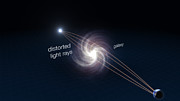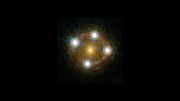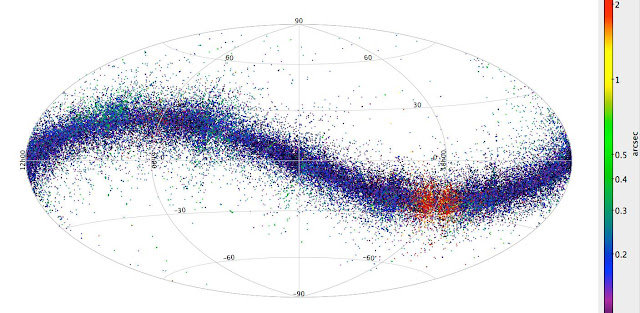The vortex mask
shown at left is made out of synthetic diamond. Viewed with an scanning
electron microscope, right, the "vortex" microstructure of the mask is
revealed. Image credit: University of Liège/Uppsala University. › Larger view
This image shows the dusty disk of planetary material surrounding the
young star HD 141569, located 380 light-years away from Earth.
Image
credit: NASA/JPL-Caltech
This image shows brown dwarf HIP
79124 B, located 23 times as far from its host star as Earth is from the
sun.
Image credit: NASA/JPL-Caltech
A new device on the W.M. Keck Observatory in Hawaii has delivered its
first images, showing a ring of planet-forming dust around a star, and
separately, a cool, star-like body, called a brown dwarf, lying near its
companion star.
The device, called a vortex coronagraph, was recently installed
inside NIRC2 (Near Infrared Camera 2), the workhorse infrared imaging
camera at Keck. It has the potential to image planetary systems and
brown dwarfs closer to their host stars than any other instrument in the
world.
"The vortex coronagraph allows us to peer into the regions around
stars where giant planets like Jupiter and Saturn supposedly form," said
Dmitri Mawet, research scientist at NASA's Jet Propulsion Laboratory
and Caltech, both in Pasadena. "Before now, we were only able to image
gas giants that are born much farther out. With the vortex, we will be
able to see planets orbiting as close to their stars as Jupiter is to
our sun, or about two to three times closer than what was possible
before."
The new vortex results are presented in two papers, both published in
the January 2017 issue of The Astronomical Journal. One study, led by
Gene Serabyn of JPL, the overall lead of the Keck vortex project,
presents the first direct image of the brown dwarf called HIP79124 B.
This brown dwarf is located 23 astronomical units from a star (an
astronomical unit is the distance between our sun and Earth) in a nearby
star-forming region called Scorpius-Centaurus.
"The ability to see very close to stars also allows us to search for
planets around more distant stars, where the planets and stars would
appear closer together. Having the ability to survey distant stars for
planets is important for catching planets still forming," said Serabyn.
He also led a team that tested a predecessor of the vortex device on the
Hale Telescope at Caltech's Palomar Observatory, near San Diego. In
2010, the team secured high-contrast images of three planets orbiting in the distant reaches of the star system called HR8799.
The second vortex study, led by Mawet, presents an image of the
innermost of three rings of dusty, planet-forming material around the
young star called HD141569A. The results, when combined with infrared
data from NASA's Spitzer and WISE missions, and the European Space
Agency's Herschel mission, reveal that the star's planet-forming
material is made up of pebble-size grains of olivine, one of the most
abundant silicates in Earth's mantle. The data also show that the
temperature of the innermost ring imaged by the vortex is about minus
280 degrees Fahrenheit (100 Kelvin, or minus 173 degrees Celsius), a bit
warmer than our asteroid belt.
"The three rings around this young star are nested like Russian dolls
and undergoing dramatic changes reminiscent of planetary formation,"
said Mawet. "We have shown that silicate grains have agglomerated into
pebbles, which are the building blocks of planet embryos."
About the vortex coronagraph
The vortex was invented in 2005 by Mawet while he was at the
University of Liege in Belgium. The Keck vortex coronagraph was built by
a combination of the University of Liege, Uppsala University in Sweden,
JPL and Caltech.
The first science images and results from the vortex instrument
demonstrate its ability to image planet-forming regions hidden under the
glare of stars. Stars outshine planets by a factor of few thousand to a
few billion, making the dim light of planets very difficult to see,
especially for planets that lie close to their stars. To deal with this
challenge, researchers have invented Instruments called coronagraphs,
which typically use tiny masks to block the starlight, much like
blocking the bright sun with your hand or a car visor to see better.
What makes the vortex coronagraph unique is that it does not block
the starlight with a mask, but instead redirects light away from the
detectors using a technique in which light waves are combined and
canceled out. Because the vortex doesn't require an occulting mask, it
has the advantage of taking images of regions closer to stars than other
coronagraphs. Mawet likens the process to the eye of a storm.
"The instrument is called a vortex coronagraph because the starlight
is centered on an optical singularity, which creates a dark hole at the
location of the image of the star," said Mawet. "Hurricanes have a
singularity at their centers where the wind speeds drop to zero -- the
eye of the storm. Our vortex coronagraph is basically the eye of an
optical storm where we send the starlight."
What's next for the vortex
In the future, the vortex will look at many more young planetary
systems, in particular planets near the "frost lines," which are the
region around a star where temperatures are cold enough for volatile
molecules, such as water, methane and carbon dioxide, to condense into
solid icy grains. The frost line is thought to divide a solar system
into regions where planets are likely to become rocky or gas giants.
Surveys of the frost line region by the vortex coronagraph will help
answer ongoing puzzles about a class of hot, giant planets found
extremely close to their stars -- the "hot Jupiters," and "hot
Neptunes." Did these planets first form close to the frost line and
migrate in, or did they form right next to their stars? "With a bit of
luck, we might catch planets in the process of migrating through the
planet-forming disk, by looking at these very young objects," Mawet
said.
"The power of the vortex lies in its ability to image planets very
close to their star, something that we can't do for Earth-like planets
yet," said Serabyn. "The vortex coronagraph may be key to taking the
first images of a pale blue dot like our own."
The Keck Observatory is managed by Caltech and the University of
California. In 1996, NASA joined as a one-sixth partner in the Keck
Observatory. JPL is managed by Caltech for NASA.
News Media Contact
Elizabeth Landau
Jet Propulsion Laboratory, Pasadena, Calif.
818-354-6425
elizabeth.landau@jpl.nasa.gov
Whitney Clavin
Caltech, Pasadena, Calif.
626-395-1856
wclavin@caltech.edu
Written by Whitney Clavin
Source: JPL-Caltech




























